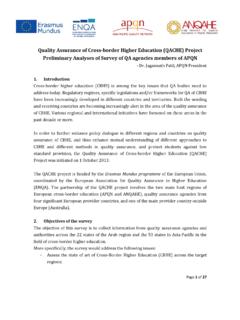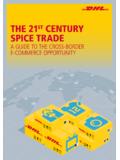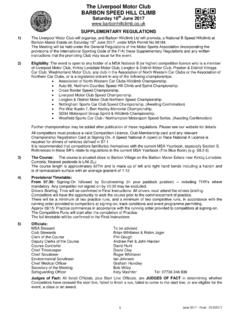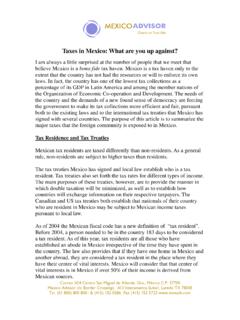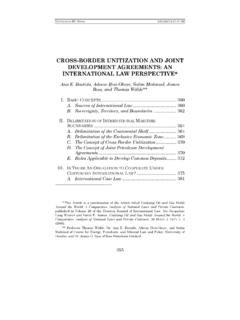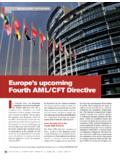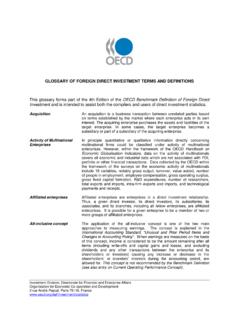Transcription of Assisted reproductive technology in Europe. Usage and ...
1 Assisted reproductive technology in europe . Usage and regulation in the context of cross-border reproductive care Patrick Pr g and Melinda C. Mills Changing families and sustainable societies: Policy contexts and diversity over the life course and across generations A project funded by European Union's Seventh Framework Programme under grant agreement no. 320116 Copyright is held by the authors. 43 (2015) Acknowledgement: The research leading to these results has received funding from the European Union's Seventh Framework Programme (FP7/2007-2013) under grant agreement no. 320116 for the research project FamiliesAndSocieties. Assisted reproductive technology in europe . Usage and regulation in the context of cross-border reproductive care*1 Patrick Pr g1 and Melinda C. Mills1 Department of Sociology and Nuffield College, University of Oxford Abstract: This study reviews Assisted reproductive technologies (ART) Usage and policies across European countries and scrutinizes emerging issues related to cross-border reproductive care (or, reproductive tourism ).
2 Although europe is the largest market for ART, the extent of Usage varies widely across countries. This can be attributed to legislation, affordability, the type of reimbursement, and norms surrounding childbearing and conception. ART legislation in europe has been growing in the past four years, with all countries now having some form of legislation. Countries with complete coverage of treatments via national health plans have the highest level of ART utilization. Legal marriage or a stable union is often a prerequisite for access to ART, with only half of European countries permitting single women and few granting access to lesbian women. Restrictive national legislation can be easily circumvented when crossing national boundaries for ART treatments, but raises important questions pertaining to safety and equity of treatments.
3 Keywords: Childlessness; In vitro fertilization; Surrogacy; Fertility treatment; Infertility Affiliation: 1) Department of Sociology and Nuffield College, University of Oxford *1 Forthcoming as a chapter in the volume Childlessness in europe . Patterns, Causes, and Contexts, edited by Michaela Kreyenfeld and Dirk Konietzka 1 Contents 1. Introduction .. 2 2. Usage of Assisted reproductive Technologies in European 4 3. Regulation of Assisted reproductive technology in europe .. 9 4. Cross-Border reproductive Care in europe .. 15 5. 18 References .. 20 2 1. Introduction Involuntary childlessness, or infertility, is a condition that affects a sizeable number of couples around the world (Mascarenhas, Flaxman, Boerma, Vanderpoel, & Stevens, 2012). Assisted reproductive technologies (ART) are an important means to address involuntary childlessness.
4 While the exact distinction between voluntary and involuntary childlessness has always been difficult to define, important reasons for childlessness, such as a perceived lack of a suitable partner or problems of balancing word and children, can be considered to be both voluntary and involuntary (Sobotka, 2010). The current trend of fertility postponement in European societies (Mills, Rindfuss, McDonald, & te Velde, 2011) has exacerbated the issue of involuntary childlessness by the fact that female fecundity declines strongly at higher ages and the heterogeneity between women in the pace of fecundity loss, making it difficult for individual women to ascertain how long they can postpone childbearing (te Velde, Habbema, Leridon, & Eijkemans, 2012; te Velde & Pearson, 2002). ART is increasingly perceived as one way to alleviate the problems of involuntary childlessness.
5 Between the birth of the first live ART baby Louise Brown in 1978 (Steptoe & Edwards, 1978) and the Nobel Prize in Physiology or Medicine to Robert G. Edwards for the development of in vitro fertilization in 2010, ART has become a standard medical practice and a profitable commercial enterprise for thousands of firms in europe . An estimated five million babies have been born with the help of Assisted reproduction in the past four decades (Adamson, Tabangin, Macaluso, & de Mouzon, 2013), a sizable share of them in europe . ART generally refers to treatments in which gametes or embryos are handled in vitro ( in glass, , outside of the body) for establishing a pregnancy. A key technique of ART is in vitro fertilization (IVF). In IVF, oocytes are fertilized using sperm in a laboratory and the embryo is surgically implanted into the woman s womb. IVF was invented for treating cases of female infertility.
6 When only a single sperm cell is injected into the oocyte during IVF, the procedure is referred to as intracytoplasmic sperm injection (ICSI). ICSI was developed to tackle male fertility problems, such as low sperm counts or poor sperm quality, but is becoming a standard form of fertilization in ART in recent years. Frozen or thawed embryo transfers refer to IVF procedures where embryos are used that have previously been cryopreserved for storage (as opposed to fresh transfers of never frozen embryos). One reason for this procedure is that obtaining oocytes from a woman is a rather invasive act. Therefore, after a hormonal treatment, several oocytes are collected at the same time, fertilized, and frozen in case the first embryo transfer fails a likely event given the 3 relatively low success rate of ART (Malizia, Hacker, & Penzias, 2009).
7 An alternative collection strategy focuses on immature eggs which are then matured in a lab (in vitro maturation), indicated when women are at risk to react adversely to the fertility drugs given before oocytes are collected. Frozen oocyte replacement is a technique where oocytes are retrieved, frozen, stored (oocyte cryopreservation), and fertilized only after thawing them for transfer. This technique allows women to preserve the future ability of having genetically related children at later points in life, even when no suitable father is present at the time of cryopreservation. Frozen oocyte replacement was first used for cancer patients before undergoing chemo- or radiotherapy (which will likely damage their testes or ovaries), however it can also be used for delaying motherhood for any reason, for instance for having a work career. This option generated substantial public attention in recent years under the name social freezing (Mertes & Pennings, 2011).
8 Large companies such as Facebook and Apple have recently included social freezing for female employees as an employment benefit, offering them up to $20,000 towards egg freezing (Tran, 2014). In cases of hereditary diseases (such as cystic fibrosis) among prospective parents, it can be useful to conduct preimplantation genetic diagnosis (PGD) or screening (PGS), where in the former case embryos are examined for specific genetic and structural alterations and in the latter case for any aneuploidy, mutation, or DNA rearrangement. In cases of egg donation, an oocyte from a woman is fertilized and then transferred to another woman s womb. These can for instance be cases of gay male parenthood, surrogate motherhood, or when a woman is unable to have her own oocytes fertilized ( , late motherhood). Another type of egg donation is called egg sharing: Women who underwent ART can share any non-used frozen oocyte with other women, sometimes for a discount on their payments for the ART treatment.
9 Globally, europe has the largest number of ART treatments. In 2005, the most recent year for which global data are available, 56 per cent of ART aspirations2 were in europe , followed by Asia (23 per cent) and North America (15 per cent) (Zegers-Hochschild et al., 2014). Given that many European countries have been characterized as having the lowest-low fertility (Kohler, Billari, & Ortega, 2002), ART is sometimes expected to not only be a means to alleviate the individual sufferings from involuntary childlessness, but also as a potential policy lever to raise fertility rates in europe , thus interest in ART is substantial. 2 Aspirations are initiated ART cycles in which one or more follicles are punctured and aspirated irrespective of whether or not oocytes are retrieved. See Footnote 3 for more details on metrics with which ART treatments are recorded.
10 4 Another key aspect of ART in europe is the stark variation in terms of ART uptake and ART regulations both across countries and over time. This variation in terms of regulations between and within European countries allows comparisons that potentially yield important insights in the antecedents and outcomes of ART Usage that might have implications for ART globally. The aim of the current study is to present comparative data on ART Usage in europe , demonstrating the wide variability across European countries. In a second step, we will explore forms of ART governance across European countries, illustrating the variation in how ART is regulated and who gets access to which techniques. We then turn to the specific case of surrogacy, which has often fallen outside of ART legislation. We conclude with a related discussion on cross-border reproductive care sometimes characterized as reproductive tourism.

